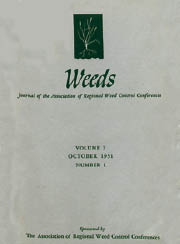Article contents
Effect of Sucrose on the Toxicity of Several Phenylurea Herbicides to Barley
Published online by Cambridge University Press: 12 June 2017
Extract
Several investigators have now reported that phenylurea herbicides inhibit the photochemical activity (Hill reaction) of isolated chloroplasts. Many of the phytotoxic symptoms in plants treated with phenylurea herbicides can be explained on the basis that the herbicides have blocked the photosynthetic mechanism. This action has been suggested as the primary cause of toxicity under field conditions. The metabolic product of biochemical pathways containing the primary site of action of a herbicide can be applied to barley plants in sufficient quantity to eliminate completely some of the toxic symptoms produced by the herbicide. Geoghegan has reported that glucose applications caused an increase in the concentration required for three phenylurea compounds to inhibit growth of Chlorella vulgaris. Therefore, a determination of the effect of carbohydrates on the inhibition of growth of barley seedlings in the presence of several phenylurea herbicides seemed of interest.
Information
- Type
- Research Article
- Information
- Copyright
- Copyright © 1960 Weed Science Society of America
References
Literature Cited
- 13
- Cited by

